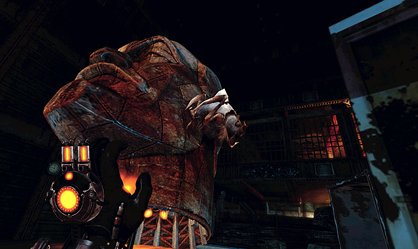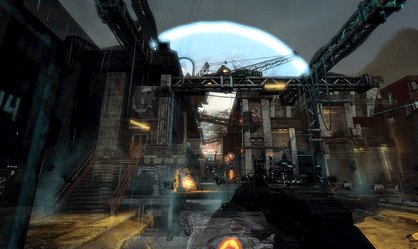Singularity - first look
This time-twisting shooter set in 50s Russia has a few temporal tricks up its sleeve
There are limits to your powers. You can only affect small items – barrels, padlocks, control panels, humans – unless you’re in one of the amplifiers that occur at unique points in the story. One of the more spectacular events we saw was the raising and rebuilding of a sunken cargo ship, which contains information that’s vital to the mission. But time doesn’t like such glaring, massive anomalies and the ship immediately attempts to re-enter its rightful, derelict state. As you navigate the corridors, and uncover the evidence of what happened in the ship, the ship is rusting around you. Pipes begin to burst, and there’s nothing your unamplified TMD can do about it. Of course, the sinking is scripted to your actions – you wouldn’t be able to get away with level design dead-ends like a timed level of this size.

But it’s huge, and it’s impressive. Which direction should you explore next? Taking a turn which won’t bring you closer to any crucial evidence sees the ship visibly groan and buckle under the weight of your poor decision. That’s not the only thing you have to worry about. The deck is strewn with the severed torsos of men who’ve been butchered by an unseen enemy, and there’s a layering on of time tricks that allows you to revisit a stable version of the new ship from the rapidly decaying, sinking version that you’ve pulled back through time. We’re still not sure if it makes sense – but it’s pretty cool.
Other timeplay on parade in the short demo included the Deadlock – a time grenade that can be used to freeze enemies in place, or to provide yourself with a shield that no bullet can penetrate. The TMD’s ping effect will scan your immediate area for traces of Element 99, giving you clues about what can be manipulated, if you get stuck. And Timegatory – a clumsy, Frankenstein’s monster of a word with Time stitched onto purgatory – forced those who died on the ship to relive their last seconds, over and over again, on a ghostly loop. These include people drowning in the air you’re breathing and men getting dragged helplessly down corridors by the boss you’re probably about to face.

There’s also an intelligent interplay between the two time zones. And not just the intermittent Time Rifts, which allow you to walk, portal-like, between the two eras and solve puzzles based on the past’s effect on the future. There’s also a more subtle use of the effect; for example, a bridge that’s broken in the Fifties is made intact by the amplified time-storm that raised the battleship. Seconds later, a crate is thrown by a (presumably behemothic, but we weren’t allowed to see) monster, redestroying the bridge. Is that time, correcting itself? Or was the bridge just broken before, erm, it got broken? Yes, paradoxes are a predictable staple of repeated time travel (don’t even start to think about parallel time lines that fracture and fragment the plot or you’ll quickly drive yourself insane), but when they’re done well, they can still make you stop and have a little think.
Weekly digests, tales from the communities you love, and more


